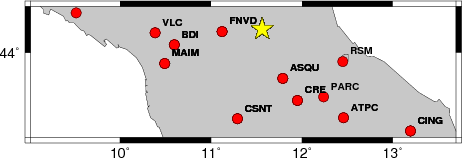
2010/09/19 00:00:58 44.186 11.563 5.0 3.50 Italy
USGS Felt map for this earthquake
USGS/SLU Moment Tensor Solution
ENS 2010/09/19 00:00:58:0 44.19 11.56 5.0 3.5 Italy
Stations used:
GU.MAIM IV.ASQU IV.ATPC IV.BDI IV.CING IV.CRE IV.CSNT
IV.FNVD IV.MSSA IV.PARC IV.RSM MN.VLC
Filtering commands used:
hp c 0.02 n 3
lp c 0.10 n 3
Best Fitting Double Couple
Mo = 1.82e+21 dyne-cm
Mw = 3.44
Z = 17 km
Plane Strike Dip Rake
NP1 0 73 -148
NP2 260 60 -20
Principal Axes:
Axis Value Plunge Azimuth
T 1.82e+21 8 128
N 0.00e+00 54 26
P -1.82e+21 34 224
Moment Tensor: (dyne-cm)
Component Value
Mxx 1.63e+19
Mxy -1.48e+21
Mxz 4.55e+20
Myy 5.23e+20
Myz 7.88e+20
Mzz -5.39e+20
########------
#############---------
################------------
##################------------
####################--------------
######################--------------
#######################---------------
##############----------###########-----
#########---------------###############-
#######------------------#################
#####--------------------#################
###----------------------#################
#------------------------#################
------------------------################
------------------------################
-------- ------------###############
------- P ------------########## #
------ -----------########### T
------------------###########
----------------############
------------##########
--------######
Global CMT Convention Moment Tensor:
R T P
-5.39e+20 4.55e+20 -7.88e+20
4.55e+20 1.63e+19 1.48e+21
-7.88e+20 1.48e+21 5.23e+20
Details of the solution is found at
http://www.eas.slu.edu/eqc/eqc_mt/MECH.IT/20100919000058/index.html
|
STK = 260
DIP = 60
RAKE = -20
MW = 3.44
HS = 17.0
The waveform inversion is preferred.
The following compares this source inversion to others
USGS/SLU Moment Tensor Solution
ENS 2010/09/19 00:00:58:0 44.19 11.56 5.0 3.5 Italy
Stations used:
GU.MAIM IV.ASQU IV.ATPC IV.BDI IV.CING IV.CRE IV.CSNT
IV.FNVD IV.MSSA IV.PARC IV.RSM MN.VLC
Filtering commands used:
hp c 0.02 n 3
lp c 0.10 n 3
Best Fitting Double Couple
Mo = 1.82e+21 dyne-cm
Mw = 3.44
Z = 17 km
Plane Strike Dip Rake
NP1 0 73 -148
NP2 260 60 -20
Principal Axes:
Axis Value Plunge Azimuth
T 1.82e+21 8 128
N 0.00e+00 54 26
P -1.82e+21 34 224
Moment Tensor: (dyne-cm)
Component Value
Mxx 1.63e+19
Mxy -1.48e+21
Mxz 4.55e+20
Myy 5.23e+20
Myz 7.88e+20
Mzz -5.39e+20
########------
#############---------
################------------
##################------------
####################--------------
######################--------------
#######################---------------
##############----------###########-----
#########---------------###############-
#######------------------#################
#####--------------------#################
###----------------------#################
#------------------------#################
------------------------################
------------------------################
-------- ------------###############
------- P ------------########## #
------ -----------########### T
------------------###########
----------------############
------------##########
--------######
Global CMT Convention Moment Tensor:
R T P
-5.39e+20 4.55e+20 -7.88e+20
4.55e+20 1.63e+19 1.48e+21
-7.88e+20 1.48e+21 5.23e+20
Details of the solution is found at
http://www.eas.slu.edu/eqc/eqc_mt/MECH.IT/20100919000058/index.html
|
The focal mechanism was determined using broadband seismic waveforms. The location of the event and the and stations used for the waveform inversion are shown in the next figure.

|
|
|
The program wvfgrd96 was used with good traces observed at short distance to determine the focal mechanism, depth and seismic moment. This technique requires a high quality signal and well determined velocity model for the Green functions. To the extent that these are the quality data, this type of mechanism should be preferred over the radiation pattern technique which requires the separate step of defining the pressure and tension quadrants and the correct strike.
The observed and predicted traces are filtered using the following gsac commands:
hp c 0.02 n 3 lp c 0.10 n 3The results of this grid search from 0.5 to 19 km depth are as follow:
DEPTH STK DIP RAKE MW FIT
WVFGRD96 1.0 50 45 -60 3.07 0.3160
WVFGRD96 2.0 55 45 -55 3.15 0.3486
WVFGRD96 3.0 70 55 -25 3.14 0.3625
WVFGRD96 4.0 265 60 0 3.17 0.3998
WVFGRD96 5.0 260 55 -10 3.24 0.4335
WVFGRD96 6.0 260 55 -5 3.26 0.4596
WVFGRD96 7.0 265 55 5 3.28 0.4814
WVFGRD96 8.0 265 60 5 3.28 0.4996
WVFGRD96 9.0 260 65 -20 3.31 0.5228
WVFGRD96 10.0 260 65 -20 3.32 0.5438
WVFGRD96 11.0 260 65 -20 3.34 0.5610
WVFGRD96 12.0 260 65 -20 3.36 0.5751
WVFGRD96 13.0 260 65 -20 3.37 0.5854
WVFGRD96 14.0 260 65 -20 3.39 0.5951
WVFGRD96 15.0 260 60 -20 3.41 0.6003
WVFGRD96 16.0 260 60 -20 3.42 0.6028
WVFGRD96 17.0 260 60 -20 3.44 0.6039
WVFGRD96 18.0 260 60 -20 3.45 0.6016
WVFGRD96 19.0 260 60 -20 3.46 0.5966
WVFGRD96 20.0 265 60 -15 3.47 0.5896
WVFGRD96 21.0 265 60 -15 3.48 0.5813
WVFGRD96 22.0 265 60 -15 3.49 0.5714
WVFGRD96 23.0 265 60 -15 3.50 0.5598
WVFGRD96 24.0 265 60 -15 3.50 0.5455
WVFGRD96 25.0 265 65 -15 3.51 0.5331
WVFGRD96 26.0 260 65 -20 3.51 0.5206
WVFGRD96 27.0 260 65 -20 3.53 0.5099
WVFGRD96 28.0 260 65 -20 3.54 0.5033
WVFGRD96 29.0 255 65 -25 3.56 0.4983
The best solution is
WVFGRD96 17.0 260 60 -20 3.44 0.6039
The mechanism correspond to the best fit is
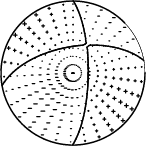
|
|
|
The best fit as a function of depth is given in the following figure:
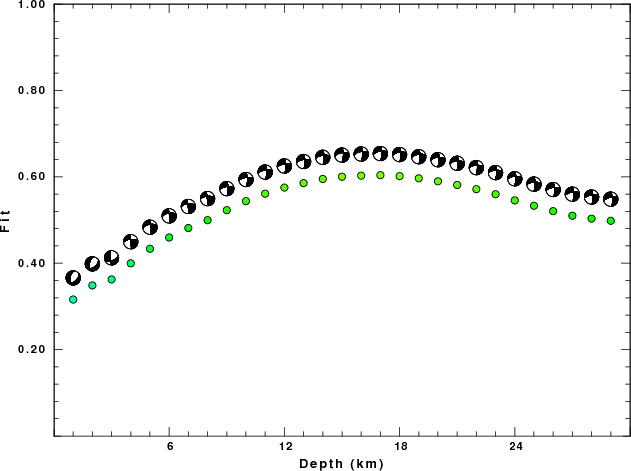
|
|
|
The comparison of the observed and predicted waveforms is given in the next figure. The red traces are the observed and the blue are the predicted. Each observed-predicted component is plotted to the same scale and peak amplitudes are indicated by the numbers to the left of each trace. A pair of numbers is given in black at the right of each predicted traces. The upper number it the time shift required for maximum correlation between the observed and predicted traces. This time shift is required because the synthetics are not computed at exactly the same distance as the observed and because the velocity model used in the predictions may not be perfect. A positive time shift indicates that the prediction is too fast and should be delayed to match the observed trace (shift to the right in this figure). A negative value indicates that the prediction is too slow. The lower number gives the percentage of variance reduction to characterize the individual goodness of fit (100% indicates a perfect fit).
The bandpass filter used in the processing and for the display was
hp c 0.02 n 3 lp c 0.10 n 3
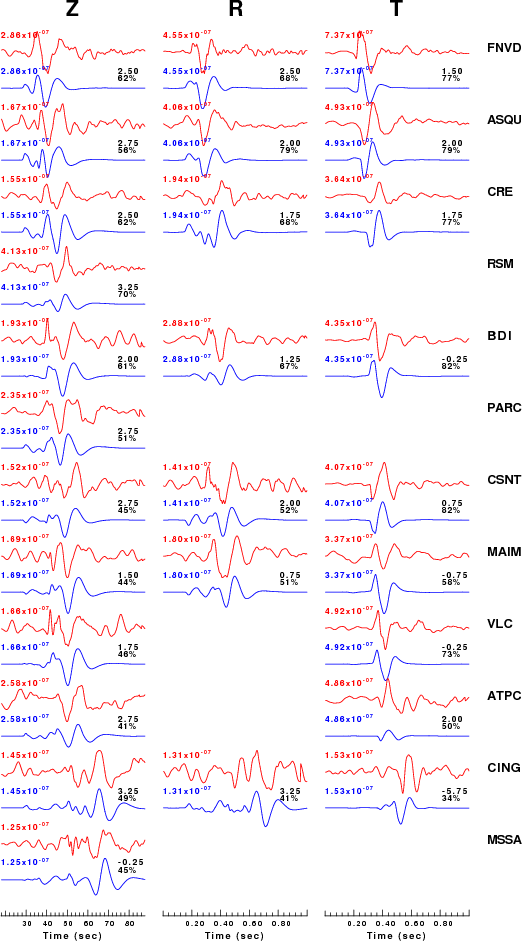
|
|
|
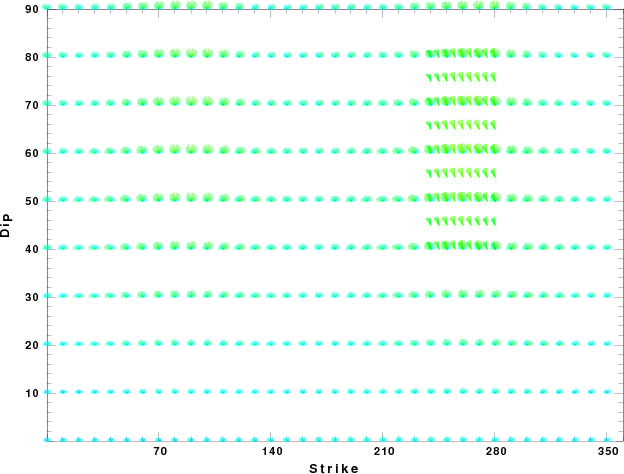
|
| Focal mechanism sensitivity at the preferred depth. The red color indicates a very good fit to thewavefroms. Each solution is plotted as a vector at a given value of strike and dip with the angle of the vector representing the rake angle, measured, with respect to the upward vertical (N) in the figure. |
A check on the assumed source location is possible by looking at the time shifts between the observed and predicted traces. The time shifts for waveform matching arise for several reasons:
Time_shift = A + B cos Azimuth + C Sin Azimuth
The time shifts for this inversion lead to the next figure:
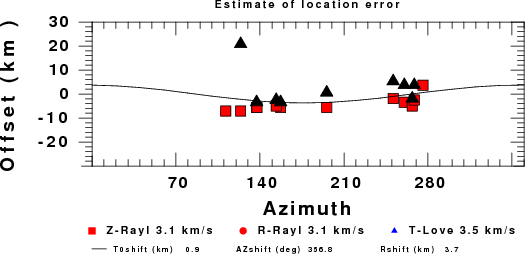
The derived shift in origin time and epicentral coordinates are given at the bottom of the figure.
The nnCIA used for the waveform synthetic seismograms and for the surface wave eigenfunctions and dispersion is as follows:
MODEL.01
C.It. A. Di Luzio et al Earth Plan Lettrs 280 (2009) 1-12 Fig 5. 7-8 MODEL/SURF3
ISOTROPIC
KGS
FLAT EARTH
1-D
CONSTANT VELOCITY
LINE08
LINE09
LINE10
LINE11
H(KM) VP(KM/S) VS(KM/S) RHO(GM/CC) QP QS ETAP ETAS FREFP FREFS
1.5000 3.7497 2.1436 2.2753 0.500E-02 0.100E-01 0.00 0.00 1.00 1.00
3.0000 4.9399 2.8210 2.4858 0.500E-02 0.100E-01 0.00 0.00 1.00 1.00
3.0000 6.0129 3.4336 2.7058 0.500E-02 0.100E-01 0.00 0.00 1.00 1.00
7.0000 5.5516 3.1475 2.6093 0.167E-02 0.333E-02 0.00 0.00 1.00 1.00
15.0000 5.8805 3.3583 2.6770 0.167E-02 0.333E-02 0.00 0.00 1.00 1.00
6.0000 7.1059 4.0081 3.0002 0.167E-02 0.333E-02 0.00 0.00 1.00 1.00
8.0000 7.1000 3.9864 3.0120 0.167E-02 0.333E-02 0.00 0.00 1.00 1.00
0.0000 7.9000 4.4036 3.2760 0.167E-02 0.333E-02 0.00 0.00 1.00 1.00
Here we tabulate the reasons for not using certain digital data sets
The following stations did not have a valid response files:
DATE=Tue Sep 21 15:18:18 CDT 2010